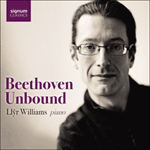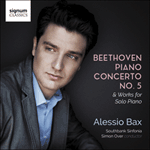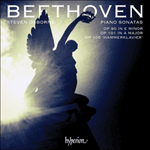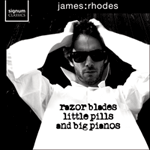
Welcome to Hyperion Records, an independent British classical label devoted to presenting high-quality recordings of music of all styles and from all periods from the twelfth century to the twenty-first.
Hyperion offers both CDs, and downloads in a number of formats. The site is also available in several languages.
Please use the dropdown buttons to set your preferred options, or use the checkbox to accept the defaults.

The sonata dates from shortly after the defeat of Napoleon, and a strong sense of patriotism was sweeping Vienna, where Beethoven resided. Perhaps for this reason he began using German rather than a foreign language to indicate the tempo and character of his sonata movements. Thus the first was marked, ‘With liveliness, and throughout with feeling and expression’, and the second, ‘Not too fast, and to be played very cantabile’.
The first movement is, as usual, in sonata form, but is quite a compact movement, without any repeat of the exposition. Its style is generally lyrical, and its first theme comes to a very definite close, which then reappears almost unaltered at the end of the whole movement. Like the first movement, the second shows very little use of counterpoint and is even more lyrical, with a gentle melody in E major that sounds more typical of Schubert than of Beethoven. This returns numerous times and the music seems almost constrained by the sonata-rondo form. In the coda, however, it takes off with greater flights of fancy, as if freed from the limits of the form; but even here the gentle, unhurried character of the whole sonata is paramount.
from notes by Barry Cooper © 2016
Cette sonate est légèrement postérieure à la défaite de Napoléon et un sens aigu de patriotisme régnait alors sur Vienne, où résidait Beethoven. C’est peut-être la raison pour laquelle il commença à utiliser l’allemand plutôt qu’une langue étrangère afin d’indiquer le tempo et le caractère des mouvements de sa sonate. Ainsi, le premier est marqué, «Avec vivacité et toujours avec sentiment et expression» et le second «Pas trop vite et très cantabile».
Comme d’habitude, le premier mouvement est en forme sonate, mais c’est un mouvement assez compact, sans la moindre reprise de l’exposition. Son style est généralement lyrique et son premier thème se termine comme une véritable conclusion, qui réapparaît presque inchangée à la fin du mouvement. Comme le premier mouvement, le deuxième fait très peu appel au contrepoint et est encore plus lyrique, avec une douce mélodie en mi majeur qui semble plus typique de Schubert que de Beethoven. Elle revient de nombreuses fois et la musique semble presque contrainte par la forme rondo-sonate. Toutefois, dans la coda, elle décolle avec des idées encore plus folles, comme si elle était libérée des limites de la forme; mais, même ici, le caractère doux et tranquille de toute la sonate passe avant tout.
extrait des notes rédigées par Barry Cooper © 2016
Français: Marie-Stella Pâris
Die Sonate entstand kurz nach der Niederlage Napoleons, und durch Beethovens Wien wehte ein starker patriotischer Geist. Vielleicht notierte er Tempo und Charakter der Sätze deswegen auf Deutsch. Die Bezeichnung des ersten lautet: „Mit Lebhaftigkeit und durchaus mit Empfindung und Ausdruck“, die des zweiten „Nicht zu geschwind und sehr singbar vorgetragen“.
Der erste Satz steht wie üblich in Sonatenform, ist jedoch eher knapp gehalten; die Exposition wird nicht wiederholt. Die Grundhaltung ist lyrisch, und das erste Thema findet einen sehr klaren Abschluss, der unverändert auch den ganzen Satz beschließen wird. Der zweite Satz macht, wie der erste, wenig Gebrauch vom Kontrapunkt und wirkt noch lyrischer; die zärtliche Melodie in E-Dur klingt eher nach Schubert als nach Beethoven. Sie kehrt mehrmals wieder, und die Musik wirkt beinahe beengt von der Form des Sonatenrondos. In der Coda entfaltet sie sich, befreit von den Grenzen der Form, mit größerer Freiheit; doch selbst hier herrscht der zarte, gemächliche Charakter vor, der die gesamte Sonate prägt.
aus dem Begleittext von Barry Cooper © 2016
Deutsch: Friedrich Sprondel
 Beethoven: Beethoven Unbound Beethoven: Beethoven UnboundA comprehensive new cycle of the Beethoven sonatas recorded live at London's Wigmore Hall during the pianist's epic fourth rendition of these masterpieces .» More |
 Beethoven: Piano Concerto No 5 & works for solo piano Beethoven: Piano Concerto No 5 & works for solo pianoAlessio Bax returns to Signum with frequent partners the Southbank Sinfonia and Simon Over in a new recording of works by Beethoven which includes the majestic 'Emperor' piano concerto.» More |
 Beethoven: Piano Sonatas Opp 90, 101 & 106 Beethoven: Piano Sonatas Opp 90, 101 & 106Three of Beethoven’s greatest piano sonatas, including the Hammerklavier, in magnificent performances from Steven Osborne.» More |
 Razor blades, little pills and big pianos Razor blades, little pills and big pianos'Razor blades, little pills and big pianos' explores the emotive landscape that we call 'life'. This debut recording is somewhat of a biographical expression of James Rhodes’s complex and unorthodox journey. It was Bach, Beethoven and Chopin; not ...» More |
 Inside tracks - the James Rhodes mix tape Inside tracks - the James Rhodes mix tapeA selection of James Rhodes' personal favourites, tracks taken from his four earlier Signum albums.» More |

